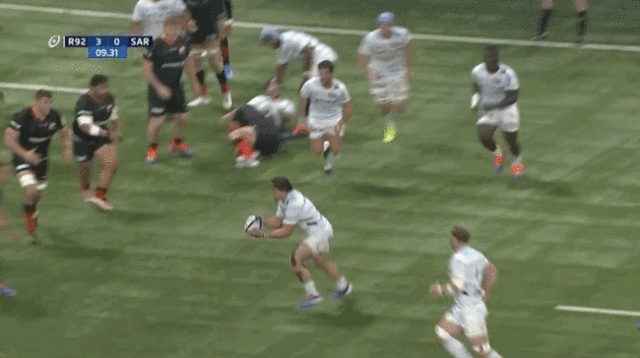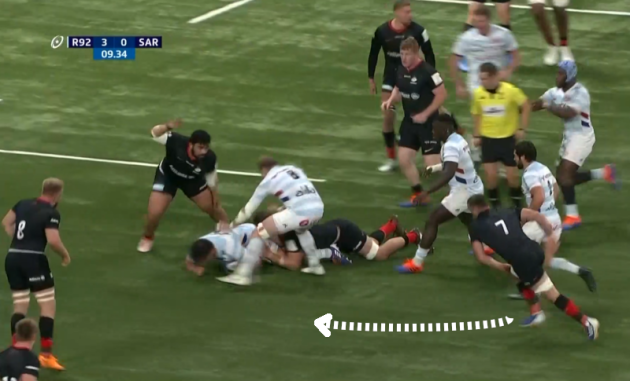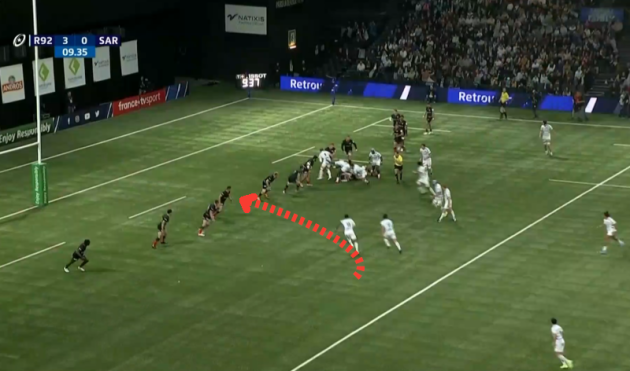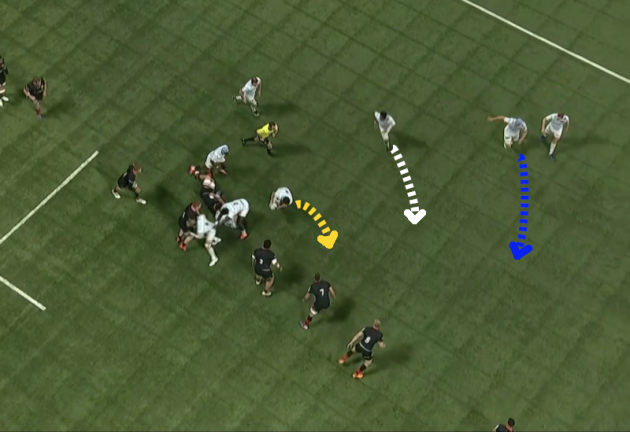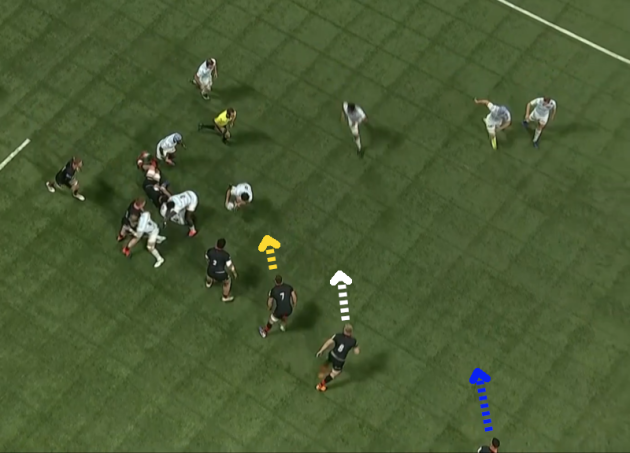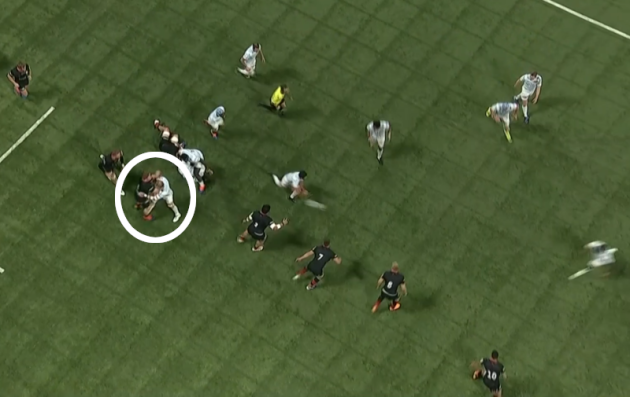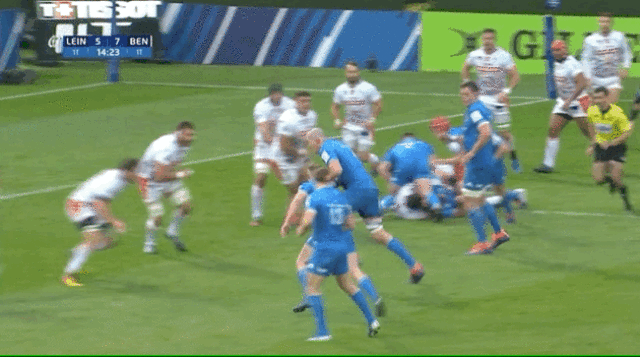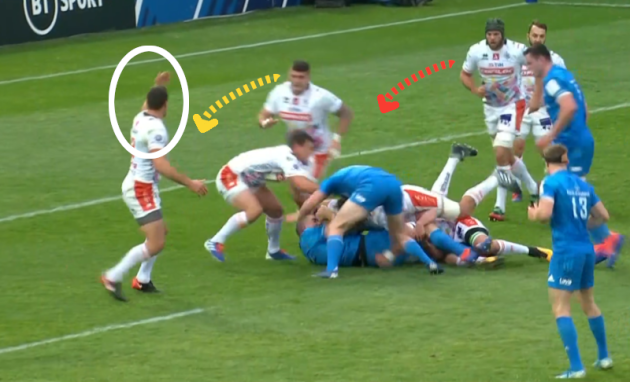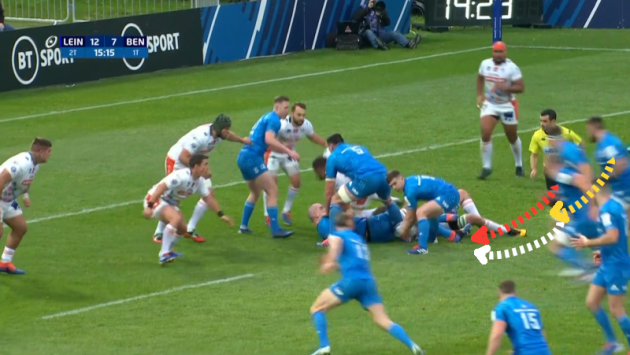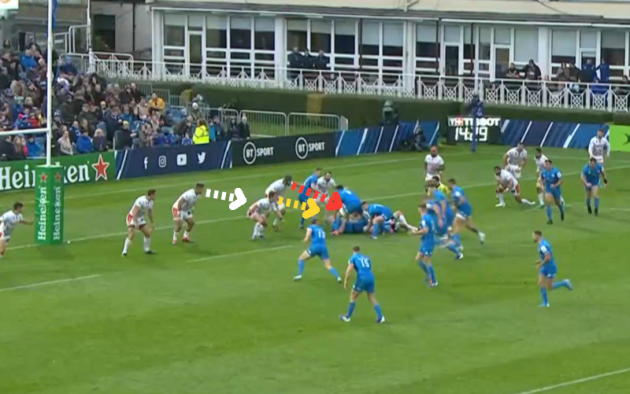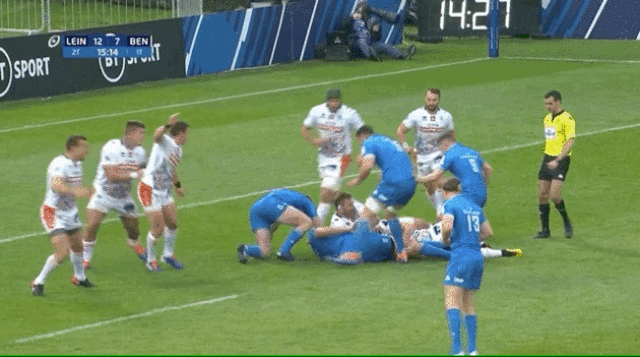RACING CENTRE VIRIMI Vakatawa was supremely effective with ball in hand during his side’s 30-10 Heineken Champions Cup win over Racing on Sunday, beating eight defenders and making four clean breaks.
Chief among his impressive contributions was a 10th-minute try as he ran a superb line to cross untouched and set Racing rolling on their way to a bonus-point win.
Vakatawa’s try was the continuation of a strong theme within the game in recent years whereby centres have been picking clever running lines off their scrum-halves with the more obvious ball-carrying forwards skipped to catch defenders off guard.
Vakatawa’s score is a perfect example.
Racing’s defensive lineout is among the best in the world and back row Baptiste Chouzenoux makes a steal at the front here before the outrageously thick-necked hooker Camille Chat carries powerfully and then Vakatawa strikes.
[Click here if you cannot view the clip above]
Clearly, Chat’s explosive carry is important in laying the foundation after the lineout steal, but Vakatawa’s running line is superb.
The France international perfectly exploits the Saracens defence on his ‘blind’ line as they fail to ideally ready themselves.
Saracens aren’t helped by openside Ben Earl missing his tackle on Chat, as they lose the gainline, meaning less time to organise themselves and identify attacking threats.
Earls also has to race backwards into the defensive line [as indicated in white above] to the inside of number eight Jackson Wray.
As Racing are rapidly recycling the ball after Chat’s carry, Vakatawa [red below] is already accelerating on his excellent line, arcing from out-to-in but straightening up to pick out the space on the outside of Wray’s right shoulder.
Vakatawa’s line is of most importance but key to the success of this play is the work from scrum-half Maxime Machenaud and the forwards on their feet closest to him.
Machenaud picks up the ball and scoots away from the ruck to his left [yellow below], offering an instant threat to the Saracens defence.
Meanwhile, we can see that Racing lock Boris Palu [white] and flanker Wenceslas Lauret [blue] have worked hard to get around the corner to offer viable ball-carrying options off scrum-half Machenaud.
The combined effect of this trio’s work is that Saracens’ defence, still scrambling in reaction to the lost lineout and missed tackle, all end up with their heads turned inwards towards the ball, rather than scanning for any other threats.
Earl [yellow below] is worried about Machenaud’s run, while Wray [white] is concerned about Palu and Lauret, as is Saracens out-half Manu Vunipola [blue] on his outside.
We can see above how space has already opened up between Wray and Vunipola as they set in defence, and it’s exactly that hole that Vakatawa is going to run into.
Outside of Vunipola, centres Nick Tompkins [green below] and Alex Lozowski [pink] also have their heads turned in. Tompkins briefly glanced up just before this point but there doesn’t seem to be any communication in that Vakatawa has picked this line.
As the France centre accelerates onto Machenaud’s expertly-delivered pass, Saracens simply have no time to react and adjust.
It’s also worth noting that Racing centre Henry Chavancy fades out behind Vakatawa, while back three players Teddy Thomas, Brice Dulin, and Juan Imhoff are all holding wider, deeper positions, meaning Saracens do have to worry about a wide attack.
One other minor thing to highlight is Racing number eight Antonie Claassen getting beyond the breakdown to briefly impede Saracens prop Rhys Carré [white below].
It’s extremely unlikely that Carré would have been able to sweep across to stop the rapid-moving Vakatawa but it shows attention to detail from Claassen and Racing.
Vakatawa’s clinical score is one that will have pleased Racing attack coach Mike Prendergast, formerly of Munster, on a day when the French side made a whopping 20 clean breaks and beat a remarkable 49 defenders overall.
Prendergast’s former team will have a demanding task keeping the dangerous Vakatawa and Racing quiet on Saturday in Thomond Park.
Leinster scored a similar try to Vakatawa’s through outside centre Garry Ringrose in their victory at home to Benetton the day before Racing’s big win in Paris.
Ireland international Ringrose doesn’t attack the ball on an identical running line here but the principles are similar.
[Click here if you cannot view the clip above]
As we can see clearly above, Ringrose is set up close to the ruck early, rather than attacking the ball from a deeper, more hidden starting position than Vakatawa.
He ends up receiving the ball from scrum-half Luke McGrath in a similar position, however, as Benetton’s defence has similar problems to Saracens’ in the first example.
Devin Toner’s carry commits two Benetton tacklers, while out-half Ian Keatley is drawn in towards the contest too.
As a result, Benetton centre Alberto Sgarbi [circled in white above] realises the defence is short of numbers on their right side of the ruck and calls for team-mates to fold around the corner.
Prop Marco Riccioni [yellow] and lock Giovanni Pettinelli [red] do make it around the corner as Leinster launch the scoring phase, but Benetton aren’t ideally set in defence.
Again the runs of forwards close to scrum-half McGrath are key here, as Rhys Ruddock [white below], Caelan Doris [red], and Andrew Porter [red] accelerate around the corner.
Again, the defenders’ eyes are all drawn inwards without any early identification of the other threats slightly further out from the ruck.
While scrum-half McGrath doesn’t scoot away from the ruck here, he does recognise Ringrose’s thinking to run that hard, flat line outside the pod of forwards.
Sgarbi will obviously have been disappointed with his tackle attempt here, but Ringrose’s finish is strong as he takes advantage of being essentially unmarked for a brief moment.
In the split-second below, Benetton prop Riccioni [white] is worried about those Leinster forward runners, while Sgarbi [pink] is expecting to have to defend a wider pass, with Ringrose’s run [red] exploiting the momentary confusion.
Sgarbi briefly glances up just after calling for team-mates to fold around the corner and has seen Johnny Sexton, Jordan Larmour and Dave Kearney assembling out the back for a possible wider attack.
In this split second, no one is actually marking up on Ringrose.
As the Leinster centre receives the ball, Sgarbi does turn back inwards but Ringrose is initially running into Riccioni’s channel before he steps aggressively outside the prop off his right foot.
[Click here if you cannot view the clip above]
Sgarbi is late in fully committing to the tackle and Ringrose is able to power his way over for the try.
As mentioned earlier, these kinds of lines from centres are a strong theme within the game in recent seasons and we have seen them regularly from Irish teams.
Munster’s Chris Farrell is excellent at thundering onto this kind of ‘hidden’ line, Ireland have used Bundee Aki and Robbie Henshaw to great effect in similar fashion, while teams from all over the world – including but not limited to Scotland, the Crusaders, Glasgow and Georgia – have all had notable successes with this type of play.
This type of tactic is particularly useful in instances inside the opposition 22 like the two above, where the defenders are more likely to be expecting forwards to carry the ball.
While aware defences can make dominant hits if they pick up the centres early, these two successes show that this kind of play is a useful part of any attacking armoury.
